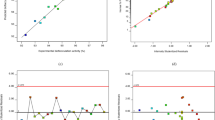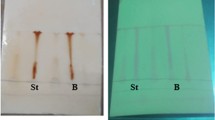Abstract
A stirring bioreactor packed with a carbon fiber textiles (FT) biofilm formed by Bacillus subtilis was used to produce vanillin from ferulic acid. Biofilm formation was characterized by scanning electron microscopy. The interactive effects of three variables on vanillin molar yield (M) and conversion efficiency of ferulic acid (E) were evaluated by response surface methodology (RSM) with a Box-Behnken design (BBD). The optimal conversion conditions with a maximum overall desirability D of 0.983 were obtained by a desirability function. Considering the actual operation, the confirmation tests were performed using the slightly modified optimal conditions (initial ferulic acid concentration 1.55 g/L, temperature 35°C, stirring speed 220 rpm). The results showed that M and E were 57.42 and 93.53%, respectively. This was only 1.03% and 1.87%, respectively, different from the predicted values, confirming the validity of the predicted models. These revealed that the stirred packed reactor could be successfully used in vanillin bioconversion from ferulic acid.
Similar content being viewed by others
References
Ma Xk, Daugulis AJ. Effect of bioconversion conditions on vanillin production by Amycolatopsis sp. ATCC 39116 through an analysis of competing byproduct formation. Bioproc. Biosyst. Eng. 37: 891–899 (2014)
Vyrides I, Agathangelou M, Dimitriou R, Souroullas K, Salamex A, Ioannou A, Koutinas M. Novel Halomonas sp. B15 isolated from Larnaca Salt Lake in Cyprus that generates vanillin and vanillic acid from ferulic acid. World J. Microb. Biot. 31: 1291–1296 (2015)
Di Gioia D, Luziatelli F, Negroni A, Ficca AG, Fava F, Ruzzi M. Metabolic engineering of Pseudomonas fluorescens for the production of vanillin from ferulic acid. J. Biotechnol. 156: 309–316 (2011)
Kasana RC, Sharma UK, Sharma N, Sinha AK. Isolation and identification of a novel strain of Pseudomonas chlororaphis capable of transforming isoeugenol to vanillin. Curr. Microbiol. 54: 457–461 (2007)
Lee EG, Yoon SH, Das A, Lee SH, Li C, Kim JY, Choi MS, Oh DK, Kim SW. Directing vanillin production from ferulic acid by increased acetyl-CoA consumption in recombinant Escherichia coli. Biotechnol. Bioeng. 102: 200–208 (2009)
Ma Xk, Daugulis AJ. Transformation of ferulic acid to vanillin using a fed-batch solid-liquid two-phase partitioning bioreactor. Biotechnol. Progr. 30: 207–214 (2014)
Kaur B, Chakraborty D. Biotechnological and molecular approaches for vanillin production: A review. Appl. Biochem. Biotech. 169: 1353–1372 (2013)
de Faveri D, Torre P, Aliakbarian B, Domínguez JM, Perego P, Converti A. Response surface modeling of vanillin production by Escherichia coli JM109pBB1. Biochem. Eng. J. 36: 268–275 (2007)
Najafpour G, Younesi H, Ismail KSK. Ethanol fermentation in an immobilized cell reactor using Saccharomyces cerevisiae. Bioresource Technol. 92: 251–260 (2004)
Torre P, de Faveri D, Perego P, Ruzzi M, Barghini P, Gandolfi R, Converti A. Bioconversion of ferulate into vanillin by Escherichia coli strain JM109/pBB1 in an immobilized-cell reactor. Ann. Microbiol. 54: 517–527 (2004)
Kourkoutas Y, Bekatorou A, Banat IM, Marchant R, Koutinas AA. Immobilization technologies and support materials suitable in alcohol beverages production: A review. Food Microbiol. 21: 377–397 (2004)
Miller PR, Gittard SD, Edwards TL, Lopez DM, Xiao X, Wheeler DR, Monteiro- Riviere NA, Brozik SM, Polsky R, Narayan RJ. Integrated carbon fiber electrodes within hollow polymer microneedles for transdermal electrochemical sensing. Biomicrofluidics 5: 013415–013428 (2011)
Barghini P, Montebove F, Ruzzi M, Schiesser A. Optimal conditions for bioconversion of ferulic acid into vanillic acid by Pseudomonas fluorescens BF13 cells. Appl. Microbiol. Biot. 49: 309–314 (1998)
Islam R, Sparling R, Cicek N, Levin DB. Optimization of influential nutrients during direct cellulose fermentation into hydrogen by Clostridium thermocellum. Int. J. Mol. Sci. 16: 3116–3132 (2015)
Priefert H, Rabenhorst J, Steinbüchel A. Biotechnological production of vanillin. Appl. Microbiol. Biot. 56: 296–314 (2001)
Chen P, Li S, Yan L, Wang N, Yan X, Li H. Draft genome sequence of Bacillus subtilis type strain B7-S, which converts ferulic acid to vanillin. Genome Announc. 2: e00025–14 (2014)
Yan L, Chen P, Zhang S, Li S, Yan X, Wang N, Liang N, Li H. Biotransformation of ferulic acid to vanillin in the packed bed-stirred fermentors. Sci. Rep. 6: 34644 (2016)
Derringer G, Suich R. Simultaneous Optimization of several response variables. J. Qual. Technol. 12: 214–219 (1980)
Guilbaud M, Piveteau P, Desvaux M, Brisse S, Briandet R. Exploring the diversity of Listeria monocytogenes biofilm architecture by high-throughput confocal laser scanning microscopy and the predominance of the honeycomblike morphotype. Appl. Environ. Microb. 81: 1813–1819 (2015)
Daneshi A, Younesi H, Ghasempouri SM, Sharifzadeh M. Production of poly-3-hydroxybutyrate by Cupriavidus necator from corn syrup: Statistical modeling and optimization of biomass yield and volumetric productivity. J. Chem. Tech. Biot. 85: 1528–1539 (2010)
Gadhe A, Sonawane SS, Varma MN. Optimization of conditions for hydrogen production from complex dairy wastewater by anaerobic sludge using desirability function approach. Int. J. Hydrogen. Energ. 38: 6607–6617 (2013)
Khataee AR, Zarei M, Fathinia M, Jafari MK. Photocatalytic degradation of an anthraquinone dye on immobilized TiO2 nanoparticles in a rectangular reactor: Destruction pathway and response surface approach. Desalination 268: 126–133 (2011)
Mourabet M, El Rhilassi A, El Boujaady H, Bennani-Ziatni M, El Hamri R, Taitai A. Removal of fluoride from aqueous solution by adsorption on Apatitic tricalcium phosphate using Box–Behnken design and desirability function. Appl. Surf. Sci. 258: 4402–4410 (2012)
Shi XY, Li WW, Yu HQ. Optimization of H2 photo-fermentation from benzoate by Rhodopseudomonas palustris using a desirability function approach. Int. J. Hydrogen Energ. 39: 4244–4251 (2014)
Aghamohammadi N, bin Abdul Aziz H, Isa MH, Zinatizadeh AA. Powdered activated carbon augmented activated sludge process for treatment of semiaerobic landfill leachate using response surface methodology. Bioresource Technol. 98: 3570–3578 (2007)
Sreela Or C, Plangklang P, Imai T, Reungsang A. Co-digestion of food waste and sludge for hydrogen production by anaerobic mixed cultures: Statistical key factors optimization. Int. J. Hydrogen Energ. 36: 14227–14237 (2011)
Nguyen HDN, Yang YS, Yuk HG. Biofilm formation of Salmonella Typhimurium on stainless steel and acrylic surfaces as affected by temperature and pH level. LWT-Food Sci. Technol. 55: 383–388 (2014)
Potumarthi R, Ch S, Jetty A. Alkaline protease production by submerged fermentation in stirred tank reactor using Bacillus licheniformis NCIM-2042: Effect of aeration and agitation regimes. Biochem. Eng. J. 34: 185–192 (2007)
Sun ML, Liu SB, Qiao LP, Chen XL, Pang Xh, Shi M, Zhang XY, Qin QL, Zhou BC, Zhang YZ. A novel exopolysaccharide from deep-sea bacterium Zunongwangia profunda SM-A87: Low-cost fermentation, moisture retention, and antioxidant activities. Appl. Microbiol. Biot. 98: 7437–7445 (2014)
Zeng W, Chen G, Wang Q, Zheng S, Shu L, Liang Z. Metabolic studies of temperature control strategy on poly (?-glutamic acid) production in a thermophilic strain Bacillus subtilis GXA-28. Bioresource Technol. 155: 104–110 (2014)
Park Y, Uehara H, Teruya R, Okabe M. Effect of culture temperature and dissolved oxygen concentration on expression of a-amylase gene in batch culture of spore-forming host, Bacillus subtilis 1A289. J. Ferment. Bioeng. 84: 53–58 (1997)
Lemos M, Mergulhão F, Melo L, Simões M. The effect of shear stress on the formation and removal of Bacillus cereus biofilms. Food Bioprod. Process. 93: 242–248 (2015)
Yánez Mendizábal V, Viñas I, Usall J, Torres R, Solsona C, Teixidó N. Production of the postharvest biocontrol agent Bacillus subtilis CPA-8 using low cost commercial products and by-products. Biol. Control 60: 280–289 (2012)
Araújo JDP, Grande CA, Rodrigues AE. Structured packed bubble column reactor for continuous production of vanillin from Kraft lignin oxidation. Catal. Today 147: S330–S335 (2009)
Vang ÓK, Corfitzen CB, Smith C, Albrechtsen H-J. Evaluation of ATP measurements to detect microbial ingress by wastewater and surface water in drinking water. Water Res. 64: 309–320 (2014)
Ashengroph M, Nahvi I, Zarkesh-Esfahani H, Momenbeik F. Novel strain of Bacillus licheniformis SHL1 with potential converting ferulic acid into vanillic acid. Ann. Microbiol. 62: 553–558 (2012)
Li X, Yang J, Li X, Gu W, Huang J, Zhang K-Q. The metabolism of ferulic acid via 4-vinylguaiacol to vanillin by Enterobacter sp. Px6-4 isolated from Vanilla root. Process Biochem. 43: 1132–1137 (2008)
Motedayen N, Ismail MBT, Nazarpour F. Bioconversion of ferulic acid to vanillin by combined action of Aspergillus niger K8 and Phanerochaete crysosporium ATCC 24725. Afr. J. Biotechnol 12: 6618–6624 (2013)
Author information
Authors and Affiliations
Corresponding author
Rights and permissions
About this article
Cite this article
Chen, P., Yan, L., Zhang, S. et al. Optimizing bioconversion of ferulic acid to vanillin by Bacillus subtilis in the stirred packed reactor using Box-Behnken design and desirability function. Food Sci Biotechnol 26, 143–152 (2017). https://doi.org/10.1007/s10068-017-0019-0
Received:
Revised:
Accepted:
Published:
Issue Date:
DOI: https://doi.org/10.1007/s10068-017-0019-0




